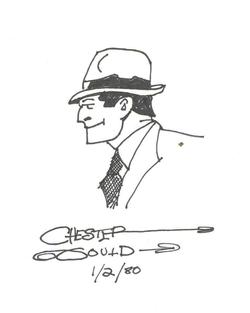
(20 November 1900 - 11 May 1985, USA)
was born in Pawnee, Oklahoma. His father didn't support his artistic ambitions, and sent him to law school. While studying however, Gould started his career drawing sport cartoons for the City Daily Oklahomian between 1921 and 1923. For the Hearst papers, he did 'The Radio Lanes' and later 'Fillum Fables', which replaced Edgar Wheelan's 'Minute Movies'
In 1931, Chester Gould's career got a boost when he sold his comic strip idea about the hard-nosed plain-clothes detective Dick Tracy to the Chicago Tribune and the New York Daily News. After 1931, he devoted his life to writing and drawing the daily 'Dick Tracy' comic. Between 1956 and 1964, the 'Dick Tracy' strip was accompanied by the funny animal topper, 'The Gravies'.
Gould's 'Dick Tracy' comic was unique for it's clever mix of suspense, grotesque villains, explicit violence, melodrama and well-documented use of scientific research methods, that were relatively new at the time. Gould also introduced innovative anti-criminal aids for policemen in his stories, such as security cameras, handheld video cameras, and most notably the two-way wrist video camera, which was developed at that moment by Gould's friend Al Gross.
Gould's work has inspired a lot of other cartoonists, like Milton Caniff and Alex Raymond. He also received the Reuben award, one of the most important awards in the comics drawing field. Gould retired in 1977, and Rick Fletcher and Alan Collins took over 'Dick Tracy'. In 1981, Gould wanted his name removed from the 'Dick Tracy' motion picture credits because he was dissatisfied with the direction the movie had taken.
(lambiek.net)
Paul S. Newman
(April 29, 1924 – May 30, 1999)
was an American writer of comic books, comic strips, and books, whose career spanned the 1940s to the 1990s. Credited in the Guinness Book of World Records as the most prolific comic-book writer, with more than 4,100 published stories totaling approximately 36,000 pages, he is otherwise best known for scripting the comic-book series Turok for 26 years.
(wikipedia.org)
 RSS Feed
RSS Feed


